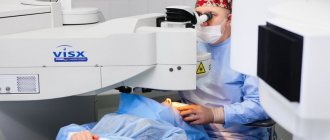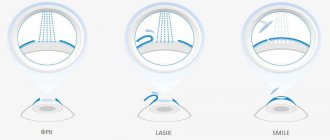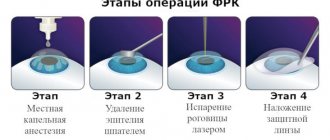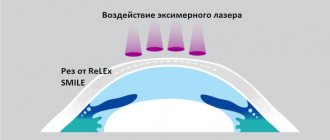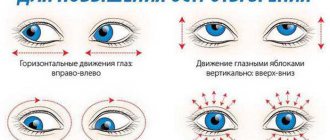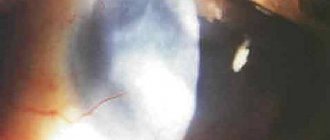Lasik is an ophthalmic surgical procedure that improves visual acuity up to 100%.
The technique has indications, contraindications and the possibility of complications.
Therefore, it is recommended to first consult with an ophthalmologist and undergo diagnostic tests to determine your health status. If there are no contraindications, the surgeon will tell you about the rules of preparation for the procedure and the rehabilitation period.
Indications for surgery
Surgery is indicated for the following deviations in visual function:
- myopia (myopia) – a decrease in visual acuity, when the patient sees well near, but poorly at a distance, is formed due to the projection of a ray of light in front of the retina, and not on it;
- hyperopia (farsightedness) – decreased visual acuity, when a person sees objects well in the distance, but poorly near them, a beam of light is projected behind the retina;
- small degree of astigmatism is a violation of the shape of the eyeball, due to which visual acuity decreases and a person incorrectly perceives the shape of objects.
To be allowed to undergo surgery, the doctor must identify an accurate diagnosis, since there are many contraindications to the procedure.
Contraindications
There is a list of conditions and diseases for which surgery cannot be performed temporarily or permanently:
- Minor age. Before the age of 25, the eyeballs increase in size and change shape. Therefore, it is considered irrational to perform surgery before this period, since vision may decrease again.
- Viral and infectious diseases in the acute stage. You must be completely cured to be cleared for surgery.
- Inflammatory eye diseases, including conjunctivitis of various natures.
- Slight thinning of the cornea, as the doctor himself makes an incision in this area using a scalpel, which increases the risk of rupture.
- A disease affecting the immune system. These include rheumatoid arthritis, rheumatism, HIV or AIDS, and congenital immunodeficiency. If surgery is performed on these diseases, the tissues will not be able to heal.
- Progressive decrease in visual acuity. If the operation is performed, it will continue to fall, so it is considered irrational.
- Pregnancy. The risk of retinal tear increases if the procedure was performed more than 6 months before pregnancy. If a woman gives birth by cesarean section, vision correction can be performed.
- Lactation. An anesthetic is dropped into the patient's eyes and passes into breast milk. Surgery is stressful for a woman, so the amount of breast milk may decrease.
If the contraindication is temporary, the patient must be completely cured before surgery can be performed. If there are absolute contraindications, the procedure is impossible.
Stages of vision correction using the Lasik method
The operation consists of several stages, about which we inform the patient for maximum comfort. Lasts about 5 minutes per eye:
- Preoperative preparation.
To make the procedure painless, we instill anesthetic drops. We fix the eyelid with a special device - an eyelid expander; this prevents involuntary movements during laser correction and does not allow the eye to close. To fix the eye, the doctor asks the patient to look motionlessly at the flashing red dot on the laser unit. - The operation itself.
Laser vision correction using the Lasik method involves affecting the deep layers of the cornea, so it is necessary to provide access to them. A superficial corneal flap no more than 150 microns thick is cut with a special instrument - a microkeratome, and then turned to the side. The laser beam forms a new “correct” configuration of the cornea by evaporating it, then the flap is returned to its place.For greater accuracy and safety of the operation, a femtosecond laser is used when creating a flap - this operation is called Femto Lasik.
- Completion.
No stitches are required - the cornea heals on its own, and over time the epithelium around the excised structures is restored. The surgical cavity of the eye is washed with a special solution, and an anti-inflammatory drug is instilled.
Laser vision correction is carried out on the same day on both eyes sequentially - all stages of the operation are repeated in the same order.
Types of Lasik correction
There are many types of procedure:
- PRK. An excimer laser is used, which mechanically changes the surface of the cornea. After the procedure, the amount of time required for rehabilitation increases.
- IFL. A lens is introduced into the human cornea, which changes the shape of this layer. The procedure is used when high visual acuity is reduced.
- Lasik. Using a surgical knife, the doctor makes an incision into the cornea, then applies a laser to the internal structure of the eyes. The corneal flap is thick and uneven, which increases the risk of complications.
- Femto Lasik. The corneal flap is cut using a femtosecond laser, so it is thin and smooth. The risk of complications is reduced.
- PresbyLasik. The technology is necessary to eliminate age-related changes in the eyeball.
- Epi Lasik. Technology for restoring visual acuity with a thin cornea.
- Super Lasik. An individual approach to each patient is used. First, the doctor, using a computer program, calculates the parameters of the corneal flap, transfers them to the laser, which cuts this area according to the specified parameters.
The type of laser vision correction required is selected by the doctor individually for each patient, depending on the health of the eyeballs.
Advantages of laser correction using the LASIK technique
- You can go back to work the very next day after the correction and begin to lead your normal lifestyle.
- The superficial layers of the cornea are not affected, and the evaporation of corneal tissue occurs from the middle layers.
- The LASIK correction procedure is performed without hospitalization, on a one-day basis.
- During LASIK correction, local drip anesthesia is used, which is easily tolerated by patients.
- Laser correction can be performed on both eyes at once.
- Wide range of applications.
- The shortest recovery period: within a few hours after correction, good vision is restored.
- High efficiency: laser correction is a painless procedure that allows you to gain good vision with a minimal risk of side effects and the shortest recovery period.
- Painlessness during the postoperative period.
- During the treatment, the upper layers of the cornea are not damaged.
- There is no postoperative corneal opacity.
- Long-term observations of patients have shown that no cases of vision deterioration as a result of laser exposure have been found.
- The high level of safety of the LASIK method and advanced laser systems of the latest generation have made this procedure for vision restoration simple and affordable.
Doctors advise all patients to protect their eyes for the first time after laser correction using the LASIK method, so that the flap does not move!
The main limitation to laser correction using the LASIK technique is the thickness of the cornea . If, for medical reasons, it is impossible for a patient to undergo laser correction using the LASIK method, he may be offered other laser correction methods, for example, Femto-LASIK , LASEK .
Cost of basic services
| Service | Price, rub.) | By map |
| Laser vision correction | ||
| Laser vision correction using the LASIK method (PRK according to medical indications) I category of complexity? A procedure for correcting vision using excimer laser correction techniques, used for myopia up to 2D. | Price 22000 ₽ | By map 20900 ₽ |
| Laser vision correction using the LASIK method (PRK according to medical indications) II category of complexity? A procedure for correcting vision using excimer laser correction techniques, used for myopia up to 4D and astigmatism up to 1D. | Price 28000 ₽ | By map 26900 ₽ |
| Laser vision correction using the LASIK method (PRK according to medical indications) III category of complexity? A procedure for correcting vision using excimer laser correction techniques, used for myopia from 4D to 6D and astigmatism over 1. | Price 35700 ₽ | By map 34100 ₽ |
| Laser vision correction using the LASIK method (PRK according to medical indications) IV category of complexity? A procedure for correcting vision using excimer laser correction techniques, used for myopia over 6D, hypermetropia, mixed astigmatism. | Price 42300 ₽ | By map 40700 ₽ |
| Femto laser support for laser vision correction? The use of a femtosecond laser instead of a mechanical instrument at one of the correction stages, which ensures the most gentle effect on the cornea and maximum results | Price 23100 ₽ | By map 23100 ₽ |
| Customized (personalized) laser vision correction LASIK? An excimer laser vision correction procedure using personalized guidance technology that allows you to take into account and compensate for any distortions in the patient’s visual system. | Price 52800 ₽ | By map 50600 ₽ |
Full price list The cost of microsurgical operations is indicated for one eye
Full price list
Devices for laser correction LASIK
There are 3 types of procedures for carrying out the technique:
- Excimer laser installation - under its influence, a smooth surface of the corneal area is formed, which promotes rapid tissue healing;
- Femtolaser – splits the corneal area at the molecular level, so the flap is thin and smooth, with even edges;
- Microkeratome – designed for corneal treatment in individually specified parameters for each patient.
To reduce the risk of complications, it is necessary to select not only a qualified doctor, but also a clinic that uses modern equipment.
The history of laser correction
The pioneer in this field was the Colombian doctor Jose Barraquer. The man owned his own clinic, where he developed the latest equipment called a microkeratome. Using equipment, the ophthalmologist for the first time performed an operation on the cornea, as a result of which it was possible to preserve its original shape. The doctor gave the procedure the name keratomileusis.
Jose’s endeavors were continued by domestic ophthalmologist Svyatoslav Fedorov. It took him ten years to perfect the technique. He introduced radial keratomy to the luminaries of medicine.
In 1968, in California, a group of scientists led by Mani Lal Bhaumik developed an excimer laser. In the eighties, Californian doctor Stephen Trockel first performed radial keratomy using this equipment. In 1987, he also performed his debut laser vision correction.
Lasik surgery was first performed in 1989 in the United States by Greek ophthalmologist Ioannis Pallikaris. However, a year earlier, the procedure was carried out by a group of doctors from Novosibirsk. A.M. Razhev and V.P. Chebotarev made a huge contribution to the development and research of laser technologies.
Preparatory procedures before surgery
To gain access to the operation, the patient must undergo the following instrumental and laboratory examinations:
- general clinical analysis of blood and urine, blood biochemistry;
- determination of visual acuity using diagnostic tables;
- Ultrasound of the eyeballs, refractometry, keratometry and other examinations as necessary;
- fluorography;
- electrocardiogram.
When gaining access to surgery, the patient must prepare for it:
- Drinking alcohol is prohibited 2 days before the procedure;
- the operation is performed on an empty stomach, so the last meal should be 8 hours before the operation;
- 2 weeks before the procedure, you should not take medications that the ophthalmologist was not aware of;
- use of antibacterial drops 3 days before surgery to eliminate the risk of infection spreading to internal tissues;
- immediately before the operation you must take a shower, your face and hair must be clean;
- It is unacceptable to use facial cosmetics before surgery, as this increases the risk of developing a bacterial infection.
Before the operation, medical personnel must warn about the presence or absence of sterile clothing in which the person must enter the operating room.
Progress of Operation LASEK
LASEK surgery is performed under local anesthesia using drops. The corneal epithelium is incised with a trephine and treated with an alcohol solution for 30 seconds.
Then, the surgeon uses a spatula to separate the epithelium and move the flap to the side. The cornea is resurfaced using an excimer laser, after which the flap is returned to its original place.
At the end of the procedure, the surgeon often installs a contact lens in the eye, which prevents displacement of the epithelial flap and also reduces discomfort after surgery.
Description of Lasik surgery
The Lasik procedure uses a laser that targets the inside of the eye. To get the effect, the doctor needs to make an incision using a surgical scalpel. The resulting flap is thick and uneven, which increases the risk of complications.
Operation stages
The procedure for restoring visual acuity is performed in several stages:
- the patient lies down on the couch, an anesthetic is instilled into his eyes, eliminating all sensations for 1-2 hours;
- a device is brought to the patient’s eyes that creates a vacuum so that the contents of the eyeballs do not leak out;
- Using a scalpel, the ophthalmologist cuts the corneal flap independently without the use of a laser;
- Using a laser, the inner area of the eyes is affected, which restores visual acuity;
- The corneal flap is applied back to its location; no stitching is required; the tissues grow together on their own.
Immediately after the operation is completed, the patient remains in the surgery department for several hours. Socialists are monitoring his condition in order to identify complications in time. If they are absent, the person is discharged home on the same day. It is recommended to call a taxi or ask relatives and close friends to come, as a temporary decrease in visual acuity is possible.
Current issues
Ë
È
Which is better: glasses, contact lenses or laser vision correction?
Glasses and contact lenses only allow you to see clearly for a while. When removing them, a person experiences stress, as vision becomes poor again. Glasses not only change a person’s appearance, but also distort the visible space and limit peripheral vision. Contact lenses, in turn, are a foreign object for the eyes. The cornea underneath gets tired, swells and experiences oxygen deficiency, and the risk of inflammatory infectious processes also increases. In addition, the daily process of putting on and taking off lenses causes microtrauma to the eye, and constant wearing of lenses can provoke the development of various corneal diseases. That is why more and more people are choosing laser correction as the most effective and safe way to correct myopia. In order to determine whether laser correction is indicated for you, you must undergo a comprehensive vision examination using modern computerized equipment. The laser correction procedure is performed within 10 - 15 minutes, under local drip anesthesia, without hospitalization. During correction using a laser beam, the surface of the cornea is not injured, since its internal layers are corrected. Improvement in vision occurs immediately after the procedure, and is completely restored within a week. The result of the correction lasts for life. Glasses and contact lenses can never provide this. Therefore, the choice is obvious.
Ë
È
Tell me, what is the duration of treatment and how long will you need to stay in the clinic after laser correction?
Laser correction is performed on an outpatient basis, and the patient spends 1.5 to 2 hours in the clinic. The impact of the excimer laser lasts from 20 to 60 seconds. The preparatory period takes 10 - 15 minutes and includes instillation of anesthetic drops, a detailed story from the doctor about how the correction will take place and how the patient feels at this time. If you have any questions while preparing for surgery, the doctor will definitely answer them. Then the patient goes to the laser correction room, and the doctor, in the presence of nurses and an engineer, carries out the correction. After excimer laser correction, the patient spends about an hour in the clinic. Then the doctor examines him, gives him drops that need to be instilled at home, and gives recommendations that need to be followed the first day after the operation. The next day you will need to appear at the clinic for a post-operative examination, and a further schedule of examinations will be prescribed by the doctor depending on the patient’s condition.
Ë
È
Will vision correction be necessary again?
In some particularly complex cases, laser correction can be performed in several stages, but most often this is not necessary.
| Ask a Question | All questions |
Rehabilitation after Lasik surgery
Immediately after the procedure, the person’s eyes become very inflamed, and after the anesthetic effect passes, acute pain, itching, and burning appear. This feeling lasts no more than 1 day. But in most cases this time is limited to a few hours. Gradually, the tissue begins to recover, so the unpleasant sensations are eliminated.
Bruises and swollen tissues form in front of the patient's eyes.
In order for the negative effects of the operation to quickly disappear and the eye tissue to heal, it is necessary to undergo the rehabilitation period correctly:
- use sunglasses outdoors for several days after surgery;
- on the first day after the procedure, it is recommended to stay in a dark room and sleep more;
- use antibacterial, moisturizing, anti-inflammatory eye drops;
- do not use your phone, computer, tablet, or TV for a long time;
- do not engage in sports activities for 1 month;
- It is not allowed to visit the sauna, bathhouse, or sunbathe for 2 months after the procedure.
The rehabilitation period lasts for 1 month. It is recommended to visit an ophthalmologist 1-2 times to examine the eyeballs. In the absence of contraindications and the presence of active tissue healing, it will gradually be possible to perform all the usual actions.
PRK – photorefractive keratectomy
This is the very first method of laser vision correction. The intervention is carried out in the superficial layers of the cornea.
Operation technique:
- A steel ring is placed on the surface of the cornea “frozen” with anesthetic. An alcohol solution is dripped inside, causing swelling, partial death and detachment of epithelial cells from the underlying tissues.
- After half a minute, dry the alcohol, remove the circle and rinse the eye.
- The epithelial layer is removed with a microsurgical instrument - a spatula or tupper, and the surface is blotted.
- The laser unit is turned on, evaporating the layers of the cornea in exact accordance with the program. The duration of exposure depends on the degree of refractive error.
- The surface is washed again and medicinal drops are instilled.
The operation itself is absolutely painless, discomfort begins after 15-30 minutes. Pain, lacrimation and photophobia accompany the patient for 3-5 days. This is due to the lack of a protective epithelial layer on the wound surface. Until complete healing occurs, symptoms of severe discomfort will persist. Vision with PRK is restored within a month.
PRK modifications
LASEK (laser assisted subepithelial keratomileusis)
Since the main cause of long-term pain is the removed epithelial layer, exposing the surface of the cornea, with this technique the epithelium is not “scraped off”, but carefully peeled off in a single layer. After the main stage - evaporation of the stroma - it is carefully placed in place and pressed with a soft contact lens. After this method of laser vision correction, postoperative discomfort is significantly less, vision is restored 1-2 weeks earlier. But the duration of the operation itself doubles.
MAGEK
With this type of PRK, the epithelium is treated with the drug Mitomycin C. It slows down the too rapid regeneration (restoration) of epithelial cells and reduces the risk of such complications as haze - temporary clouding of the cornea after laser exposure.
ASA, ASLA, C-Ten, Trans-PRK
This is the name of the same type of photorefractive keratectomy. In Russia, the name “transepithelial” PRK has taken root. With this technique, the epithelium is removed by vaporization with the same excimer laser beam. On old-type installations, such interventions were two-stage, but on modern ones, with a scanning “flying spot”, they were single-stage, more accurate.
EPI-LASIK
This method is intermediate between PRK and LASIK. The epithelium is not treated with a chemical solution, but is cut off with an epikeratome. This flap is significantly thinner than with LASIK. After the intervention is completed, it is also pressed with a contact lens, which significantly shortens the healing period.
LASIK
The main method of laser vision correction, which has several varieties. Its main advantage over PRK is the preservation of the protective surface epithelium with the surface layer of the corneal substance. The wound surface is minimal and “heals” within 24 hours, without causing the patient severe pain or severe discomfort. The laser beam evaporates the upper layers of the corneal stroma.
Operation technique:
- A vacuum ring is applied to the cornea, numbed with anesthetic drops - a ring-shaped “suction cup” with a tube through which air is sucked out.
- The microkeratome cuts off the top layer along with the epithelium within the vacuum ring. This corneal flap – the “lid” – is not completely cut off, leaving the pedicle on the periphery.
- The microkeratome is removed, and the formed corneal flap is folded to the side with a spatula.
- The exposed surface is dried and an excimer laser unit is turned on, evaporating the tissue micron by micron, following a computer program.
- The surgical field is washed and the flap is placed in place, smoothed with a damp pad and pressed. The edges are dried with a dry tuff, the moisture is absorbed and suctions the flap to the wound surface.
Unpleasant sensations after LASIK last 3-4 hours, vision is restored by the morning after the intervention.
Types of LASIK
Super LASIK
The method is based on the targeted impact of excimer laser energy on small irregularities of the cornea. This, according to the developers, allows you to achieve visual acuity above 100%. In fact, the possibility of “super vision” largely depends on the structure of the eye, the resolution of the retina and many other factors. In this regard, Super-LASIK remains rather a publicity stunt.
Femto-LASIK
In this case, another femtosecond laser is used to separate the surface layers. Its impulses form microbubbles in the thickness of the cornea at a strictly defined depth. When these microbubbles merge, it is not a cut that is formed, but a delamination of the surface, after which the surgeon removes the formed “lid.” A special feature of this flap is the edge of the cornea, formed like a groove.
The corneal section with Femto-LASIK has the same thickness throughout, which cannot be achieved when cutting with a microkeratome. This ensures maximum visual acuity in the postoperative period, increases image contrast and increases the safety of the intervention. In addition, this method of laser vision correction can be used for thinner corneas than standard LASIK.
The refractive effect on the corneal substance itself is carried out with an excimer laser.
Pesby LASIK, or multifocal
To correct age-related farsightedness, a method is being developed to form zones of different optical powers for vision at different distances. Presby-LASIK is not widely used and is in clinical trials.
Laser correction methods are constantly being improved, ophthalmic surgeons achieve maximum visual acuity, complete safety and absence of complications. So, for example, when performing standard LASIK, the probability of complications is 1:1000, with Femto-LASIK – 1:10000.
Late complications
After completion of the rehabilitation period, other complications may develop:
- insufficient restoration of vision function, which requires additional surgery or wearing glasses;
- decreased visual acuity;
- corneal flap detachment;
- changes in the shape of the eyeball, leading to astigmatism;
- retinal detachment up to complete blindness.
Late complications are dangerous for the patient, since he may not immediately notice their presence; they progress over time.
Patient reviews
Pavel, 30 years old: I wanted to restore visual acuity using the Lasik procedure, since it is cheaper. But the doctor dissuaded me, because it has many contraindications and risks of complications.
Elena, 25 years old: I chose the procedure for restoring vision using Lasik technology. The doctor warned me about the possibility of complications, but its cost is much cheaper. A year and a half has already passed since the procedure, no side effects have arisen.



